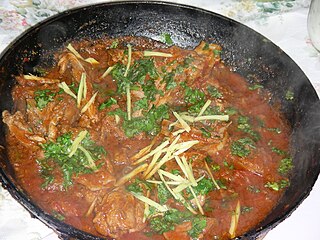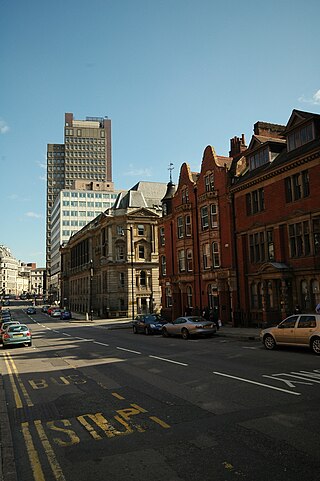
The Bull Ring is a major shopping area in central Birmingham England, and has been an important feature of Birmingham since the Middle Ages, when its market was first held. Two shopping centres have been built in the area; in the 1960s, and then in 2003; the latter is styled as one word, Bullring. When combined with Grand Central it is the United Kingdom's largest city centre based shopping centre.

The Hall of Memory is a war memorial in Centenary Square, Birmingham, England, designed by S. N. Cooke and W. N. Twist. Erected 1922–25 by John Barnsley and Son, it commemorates the 12,320 Birmingham citizens who died in World War I.
Tyseley is a district in the southern half of the city of Birmingham, England, near the Coventry Road and the districts of Acocks Green, Small Heath and Yardley. It is located near the Grand Union Canal.

A balti or bāltī gosht is a type of curry served in a thin, pressed-steel wok called a "balti bowl". The name may have come from the metal dish in which the curry is cooked, rather than from any specific ingredient or cooking technique. Balti curries are cooked quickly using vegetable oil rather than ghee, over high heat in the manner of a stir-fry, and any meat is used off the bone. This combination differs sharply from a traditional one-pot Indian curry which is simmered slowly all day. Balti sauce is based on garlic and onions, with turmeric and garam masala, among other spices.

The Custard Factory is a creative and digital business workspace complex, including independent shops, cafes and bars, on the site of what was the Bird's Custard factory off High Street, Deritend, in the Digbeth area of central Birmingham, England.

Sparkhill is an inner-city area of Birmingham, England, situated between Springfield, Hall Green and Sparkbrook.

Shirley is a town in the Metropolitan Borough of Solihull, in the West Midlands, England. Historically part of Warwickshire, neighbouring districts include Shirley Heath, Sharmans Cross, Solihull Lodge, Monkspath, Cranmore and the Hall Green district of Birmingham.

Tyseley Locomotive Works, formerly the Birmingham Railway Museum, is the engineering arm of steam railtour promoter Vintage Trains based in Birmingham, England. It occupies part of the former Great Western Railway's Tyseley depot, built in 1908 to accommodate expanding operations in the West Midlands, particularly the opening of the North Warwickshire Line as a new main line from Birmingham to Bristol.

Five Ways is an area of Central Birmingham, England. It takes its name from a major road junction, now a busy roundabout to the south-west of the city centre which lies at the outward end of Broad Street, where the Birmingham Middle ring road crosses the start of the A456.
As with any large town or city, food and drink has played an important role in the commerce and culture of Birmingham, England.

Hockley Heath is a large village and civil parish in the Arden area mostly within the Metropolitan Borough of Solihull, West Midlands, England, incorporating the hamlet of Nuthurst, with a history dating back to the year 705 AD as a wood owned by Worcester Cathedral. The parish, known as Nuthurst cum Hockley Heath, is to the south of the West Midlands conurbation, 12 miles (19 km) southeast of Birmingham 5.5 miles (8.9 km) from Solihull town centre and 12.5 miles (20.1 km) north of Stratford-upon-Avon. The village forms part of the border with Warwickshire and the District of Stratford-on-Avon to the south, with some parts of the village on either side of the border. According to the 2001 census, the parish had a population of 6,771, being measured at the 2011 Census as 2,038.

The O2 Institute (originally known as the Digbeth Institute) is a music venue located in Birmingham, England. The venue opened in 1908 as a mission of Carrs Lane Congregational Church. It has also served as an event centre, civic building and nightclub.

The Chamberlain Memorial, also known as the Chamberlain Memorial Fountain, is a monument in Chamberlain Square, Birmingham, England, erected in 1880 to commemorate the public service of Joseph Chamberlain (1836–1914), Birmingham businessman, councillor, mayor, Member of Parliament, and statesman. An inauguration ceremony was held on 20 October 1880, when Chamberlain himself was present.

Newhall Street is a street located in Birmingham, England.

Holland William Hobbiss, was an English architect in the Birmingham area. He traded under the names Holland W. Hobbiss and Partners and Holland W. Hobbiss and M. A. H. Hobbiss.
Wolverton is a village in the Stratford-on-Avon District of Warwickshire, England. The population at the 2011 census was 212.
Samuel Nathaniel Cooke Jr. was an English architect active in Birmingham, England in the early to mid 20th century. He was almost invariably credited as S. N. Cooke and his later work was carried out under the auspices of his firm S. N. Cooke and Partners. Works by him and the partnership include significant civic buildings, hospitals, and commercial premises in Birmingham and elsewhere in the United Kingdom.

Stratford House is a Grade II* listed house in the Highgate area of Birmingham, England. Dating from 1601, it is located near Camp Hill traffic island. It was built by Ambrose and Bridget Rotton whose initials are carved over the porch. There is also an insurance plate on the front. The house was originally located on a 20-acre (8.1 ha) farm owned by Ambrose, who kept sheep, oxen, cows and pigs.
The old Piccadilly Cinema building is located in Sparkhill, Birmingham, England, and is situated on the Stratford Road.
Shirley Baptist Church is a Baptist church in Solihull near Birmingham, England. The church building is situated on Stratford Road (A34) with halls facing into Trinity Place in the Parkgate pedestrianised area. The church was founded in 1797 and is a member of the Baptist Union of Great Britain and the Evangelical Alliance.















